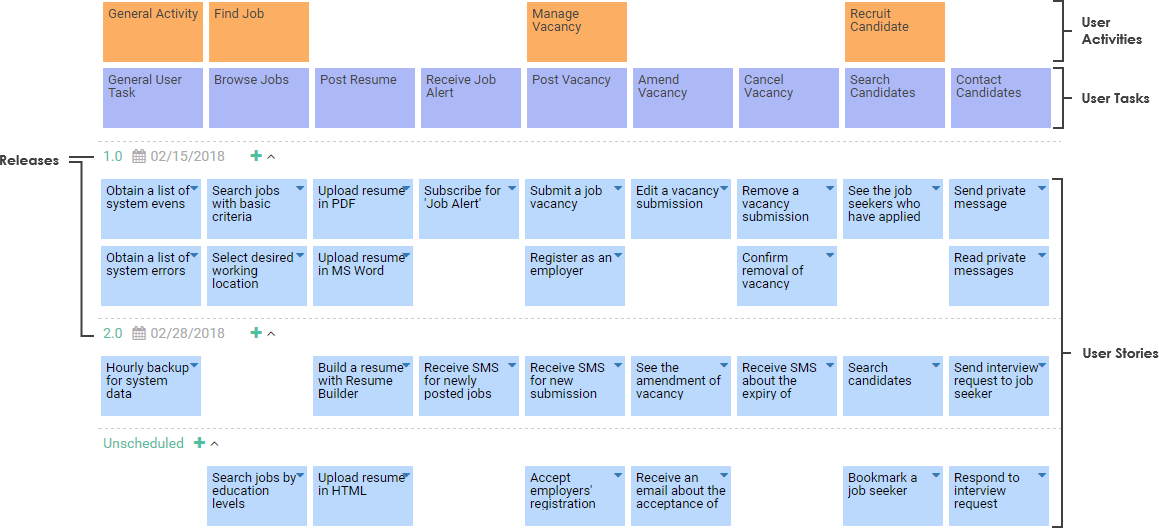A Comprehensive Guide for User Story Mapping
What is User Story Mapping?
User Story Mapping is a visual technique for organizing and prioritizing product requirements by building a map of user stories. It was developed by Jeff Patton, and it helps product teams to create a shared understanding of a product’s features and how they relate to the user’s goals.

Why is User Story Mapping Important?
User Story Mapping is important because it helps product teams to:
- Prioritize features based on user needs and goals
- Break down complex features into smaller, more manageable user stories
- Create a shared understanding of the product’s requirements and scope
- Identify gaps or missing functionality in the product
- Plan releases and sprints more effectively
- Communicate product requirements to stakeholders more clearly
How to create a User Story Map?
Here are the steps to create a User Story Map:
- Define the user persona(s): Identify the user personas that will use the product. User personas are fictional characters that represent the users of the product.
- Define the user’s goals: Identify the user’s goals and the outcomes they want to achieve by using the product.
- Create a list of features: List down all the features that are required to achieve the user’s goals.
- Organize features into themes: Group features into themes based on their functionality or user goals.
- Create user stories: Create user stories for each feature. A user story is a short, simple description of a feature from the user’s perspective.
- Prioritize user stories: Prioritize user stories based on their importance to the user’s goals.
- Map the user stories: Map the user stories on a grid. The x-axis represents the user’s journey, while the y-axis represents the level of importance.
- Identify gaps: Identify any gaps in the map and add missing user stories.
- Plan releases and sprints: Plan releases and sprints based on the user stories.
Tips for effective User Story Mapping
- Involve the entire team: User Story Mapping is a collaborative process that involves the entire product team.
- Start with the user: Always start with the user’s goals and outcomes, and work backward to identify the features required to achieve them.
- Keep it simple: User Story Mapping should be simple and easy to understand. Avoid making it too complex or detailed.
- Focus on outcomes: Focus on the outcomes the user wants to achieve, rather than the features themselves.
- Prioritize ruthlessly: Prioritize the user stories ruthlessly to ensure that you are building the most important features first.
- Be open to change: User Story Mapping is a dynamic process, so be open to changing the map as you learn more about the product and its users.
Visual Paradigm’s Story map is a powerful tool that supports a flexible 3 or 4-level hierarchical structure for requirements gathering, making it suitable for complex, medium, or simple projects. With Story map, you can start by collecting user features from different sources, such as use cases, BPMN diagrams, WBS charts, or even mind maps. These user features are then organized into a backlog of user activities, which are further broken down into related walking skeleton tasks that reflect the user’s needs.

4-level Story Map for More Complex Project

To facilitate software development, these tasks can be further divided into epics and user stories, which provide a more granular breakdown of the work required to realize the user’s goals. This hierarchical structure allows for a more efficient and effective approach to prioritizing and managing requirements, helping your team to focus on the most important features first.
Conclusion
User Story Mapping is a powerful technique for organizing and prioritizing product requirements. By creating a User Story Map, product teams can gain a shared understanding of the product’s requirements and scope, prioritize features based on user needs and goals, and plan releases and sprints more effectively. By following the steps outlined above and keeping the tips in mind, you can create an effective User Story Map that will help you build a successful product.
Overall, Visual Paradigm’s Story map provides a comprehensive solution for gathering and organizing requirements, making it an essential tool for any product team looking to build successful software products.

